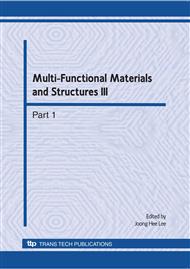p.859
p.863
p.867
p.871
p.875
p.879
p.887
p.891
p.895
Synthesis and Photophysics of Two Dipolar Copolymers Containing Hole-Transporting Unit and Alq3 Unit
Abstract:
Two novel copolymers combining the electron-transporting group (Alq3), hole-transporting group (carbazole and phenothiazine) and chromophore had been obtained. The copolymers were characterized by 1H NMR, IR and UV-vis absorption spectrum, and exhibited good solubility in a wide range of organic solvents such as toluene, THF, chloroform, DMF and DMSO. GPC shows moderate molecular masses of the copolymers around 15000 and a narrower weight distribution (PDI≈1.4). The DSC and TGA measurements indicated that the resulting copolymers have excellent thermal stability and higher glass transition temperatures than the commonly used light-emitting conjugated polymers. The PL properties of the copolymers were investigated in solution and in the solid state. Only the Alq3 emission (520 nm) was observed at high concentration (10 g/L) or in solid state. However, with the decrease in concentration of the copolymer solution, the characteristic emission of carbazole appears. This means the energy transfer taken place in higher concentration is more efficient than in lower concentration solution.
Info:
Periodical:
Pages:
875-878
Citation:
Online since:
August 2010
Authors:
Keywords:
Price:
Сopyright:
© 2010 Trans Tech Publications Ltd. All Rights Reserved
Share:
Citation:


